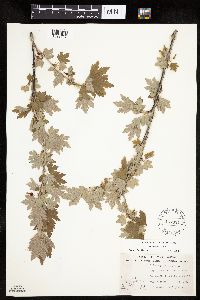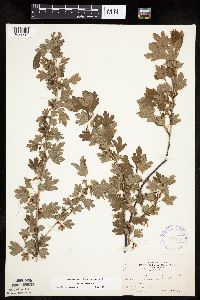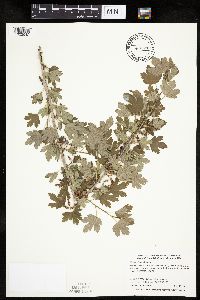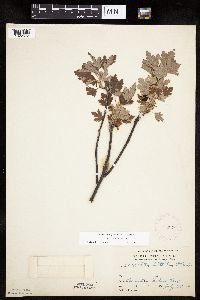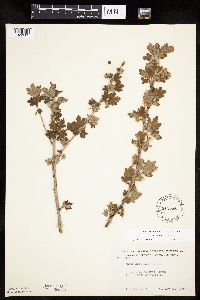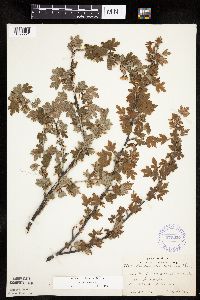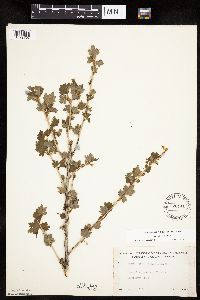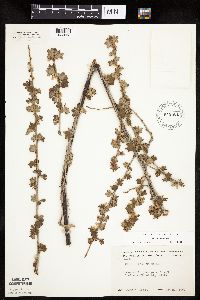Ribes hirtellum
|
|
|
|
Family: Grossulariaceae
Hairy-Stem Gooseberry
[Ribes hirtellum var. inerme Smiley] |
Plants 0.5-1.5 m. Stems erect to sprawling, glabrous or pubescent, glabrescent; spines at nodes absent or 1-3, 3-8 mm; prickles on internodes absent, sometimes present, scattered. Leaves: petiole 0.7-1.5(-2) cm, pilose; blade roundish to rhombic, 5-7-lobed, cleft nearly 1/2 to midrib, 1-2.5 cm, base broadly cuneate to truncate, surfaces softly pubescent to glabrous, not glandular, lobes cuneate, long-deltate, margins toothed, apex broadly acute. Inflorescences pendent, solitary flowers or 2-3-flowered corymbs, 0.5-1.5 cm, axis glabrous or sparsely pilose. Pedicels not jointed, 2-5 mm, glabrous; bracts ovate to deltate, 1-2 mm, villous-ciliate with simple hairs. Flowers: hypanthium greenish white, obconic to campanulate, 2-3 mm, glabrous or pilose to densely pilose; sepals not overlapping, erect, recurved in age, greenish white or with purplish tinge along margins, broadly oblong, 3-4 mm; petals connivent, erect, white to purple tinged, spatulate-obovate, not conspicuously revolute or inrolled, 1.7-2.5 mm; nectary disc not prominent; stamens 2 times as long as petals; filaments linear, 3-4.5 mm, glabrous; anthers cream, oval, 0.2-0.3 mm, apex rounded; ovary glabrous; styles connate to middle, 3-4.5 mm, villous in proximal 1/2. Berries palatable, greenish to purplish, globose, 6-7 mm, glabrous. 2n = 16. Flowering May-Jun. Rocky woods and cliffs, coastal thickets and heathlands, cedar and tamarack swamps, riverbottom forests, swales in sandhills, treed wetlands; 0-2200 m; Alta., Man., N.B., Nfld. and Labr. (Nfld.), N.S., Ont., P.E.I., Que., Sask.; Conn., D.C., Ill., Ind., Iowa, Maine, Md., Mass., Mich., Minn., Nebr., N.H., N.J., N.Y., N.Dak., Ohio, Pa., R.I., S.Dak., Vt., W.Va., Wis. Shrub to 1 m tall Leaves: alternate, stalked, 2.5 - 6 cm long, 2 - 6 cm wide, palmately three- to five-lobed, egg-shaped to round with a broadly tapering to tapering-flattened base, palmately veined, coarsely toothed, thin but firm, sometimes sparsely hairy, at least along the veins beneath. Stalk slender, 1 - 3 cm long, with a few long, feather-like hairs. Inflorescence: a solitary flower or small, short-branched cluster of up to three flowers, subtended by short bracts that bear a marginal fringe of hairs. Flowers: greenish yellow or pale purple. Stamens five, longer than petals. Styles two, divided, longer than petals. Sepals: forming a five-lobed tube (calyx). Calyx greenish yellow or pale purple, 6 - 9 mm long, tubular to bell-shaped. Lobes as long or longer than tube. Petals: five, in the throat of the calyx tube, small, alternate with calyx lobes. Fruit: a juicy berry, many-seeded, crowned by the shriveled calyx, purplish to black, 8 - 10 mm wide, spherical, smooth. Branches: slender, smooth, or with a few spines. Nodal spines one to three, 3 - 8 mm long. Similar species: The similar Ribes cynosbati differs by having prickly berries and calyx lobes that are shorter than the tube. Ribes missouriense is also similar but has white to greenish white flowers and berries that are at least 1 - 1.5 cm wide. Flowering: April to June Habitat and ecology: Rare in the Chicago Region, where it may be found in bogs and fens. Occurence in the Chicago region: native Notes: The attributes of this species may vary, especially in the leaf shape and hairiness. Etymology: Ribes comes from the Arabic name for a shrub that has acidic fruit. Hirtellum means "somewhat hairy." Author: The Morton Arboretum Much like no. 5 [Ribes oxyacanthoides L.] , and not always sharply distinct; nodal and internodal spines few and weak, or often absent; lvs softly hairy to glabrous, not glandular, often cuneate at base; bracts villous-ciliate; ovary and hypanthium often villous; fls slightly smaller; stamens and style ca twice as long as the pet, just equaling the sep; 2n=16. Rocky woods and cliffs; Nf. and Que. to Alta., s. to N.Y., Pa., n. Ind., ne. Ill., and Nebr. May, June. (R. huronense) Variable, and sometimes divided into several vars. on the basis of pubescence and lf-shape. Gleason, Henry A. & Cronquist, Arthur J. 1991. Manual of vascular plants of northeastern United States and adjacent Canada. lxxv + 910 pp. ©The New York Botanical Garden. All rights reserved. Used by permission. From Flora of Indiana (1940) by Charles C. Deam This species is restricted to the northern counties and is found only in wet places, mostly in tamarack bogs. It is infrequent to very rare in the area of its distribution. The extreme variability of this species, especially in the shape of the leaves and in the amount of pubescence on their under surface, has led to the naming of varieties of it. Writers tell us that the bases of the leaves of this species are generally more or less cuneate and that the bases of the leaves of Grossularia oxyacanthoides are truncate or cordate. I have two specimens with the bases of the leaves cordate but I think, because of other characters, that they belong to this species. I have one specimen that has a few stalked glands which do not properly belong to this species. …… Indiana Coefficient of Conservatism: C = 10 Wetland Indicator Status: FACW |















